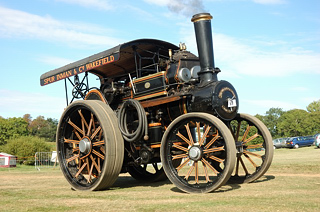Home Page → Engines → Types of Traction Engine → Road Locomotives
About Road Locomotives

These were a distinct type of traction engine designed to haul heavy loads on public roads. During the late Victorian period this consisted of large trains of trailers but due to accidents whilst hauling 5 or more unbraked trailers legislation gradually moved to outlawed this and in the later part of the steam era road locomotives were used to move large indivisible loads which could not travel by rail.
Some road locomotives were also supplied with additional showman's fittings or front mounted cranes, these were essential the same as standard road locomotives but are described in their own sections:
Makers
The four principle makes of road locomotives were:
However, more makers of general purpose engines offered road locomotive versions of the products, these included:
Design Features
Road Locomotives were broadly similar to conversional traction engines but with a number of design features to make them more suited to the transport of heavy goods. Primarily, they tended to be larger than there general purpose engine counterparts, 6, 7, 8 or 10 NHP, and they were of a much more substantial build with thicker metal used to build the hornplates and beefed up motion to cope with the strain the engines were put under when transporting large loads by road. They were commonly fitted with 3 road gears (but not always), and were generally fitted with an awning or roof to provide operators with a degree of protection from the weather. {awning picture} There was normally springing on the front and rear axles to reduce vibration whilst traveling on early roads. {springing picture} During the later part of steam engine production rubber tyres were fitted to engines and earlier engines nearly always had rubber tyres fitted to them during later life. A much less common alternative to rubber tyres was wooden block rims.
Road locomotives were nearly always fitted with a solid flywheel instead of the spoked version that was fitted to general purpose engines as well as motion covers to enclose the motion off. {picture of flywheel/motion} There are several theories as to why these features were standard issue on road locomotives, one is that spoked flywheels and visible motion had a tendency to scare horses and by altering these features horses were less likely to be spooked when the two alternative forms of transport met on the road. A second theory is that this prevent oil being thrown from the motion and covering passers-by! Nearly all Road Locomotive's were built with compound cylinders, this provided the engine with more power and was generally more efficient for the type of work the engines undertook. Early engines were ocas Burrell built a significant porsion of their road locomotive output with their single crank compound design.
Customers
Fewer road locomotives were built compared to production of standard general purpose engines and a select few of the companies operating such engines have become legendary figures in annals of steam engine operators.
Norman E Box
The jobs they undertook also meant that they were much more likely to be photographed by photographers of the day, many of these pictures survive and have been republished, further adding to the status of their owners. One company in particular, Norman E Box of Manchester were particularly sharp when it came to publicity opportunities and had photographs taken on most of the haulage jobs that they undertook, they also had an agreement with the company they purchased their engines from (Fowler) to allow them to use their photography in marketing materials.
During the later days of steam in the UK many used road locomotives were purchased by farmers for threshing and other belt work, a big engine could be particularly well suited to this. Another use was using the boiler for the sterilisation of soil, being engaged in this sort of work meant they eluded the cutters torch for longer and subsequently survived into preservation.
Overseas
Each of the major builders of Road Locomotives supplied engines for use overseas. Many of these engines were used by Armed Forces by the British in our colonies and other armies.
Following the end of the Boer and Great War's many road locomotives were sold out of the Armed Forces and on to various contractors for use in commercial work. The firm of Wm Kerr who where based in Glasgow purchased numerous engines in this way including 4??? McLaren road locomotives.
General purpose engines or colonial engines produced for use in Australia and New Zealand carried a lot of design similarities with road locomotives produced for the home market. Generally however they were not refered to as road locomotives in any literature produce by the companies.
In Preservation
Road locomotives are highly prized engines in preservation circles. Less genuine road locomotives exist than their similar showmans engines counterparts which has meant that values for them has gradually increased.
A significant number of road locomotives from British manufacturers have been returned to these shores in the last 20 years, generally these engines have differences between their counterparts built for the British market and some have been restored to the specification of a British engine.
In the early 1980's a group of road locomotive owners got together to form Amalgamated Heavy Haulage which was intended to replicate the haulage feats these engines undertook in the past. This activity was generally centred around the Great Dorset Steam Fair, then at it's Stourpaine site. This activity continues to this day and during the Great Dorset Steam fair in late August / early September these engines pull a variety of loads around a specially designated arena or 'playpen'. [picture of engine in GDSF playpen]
